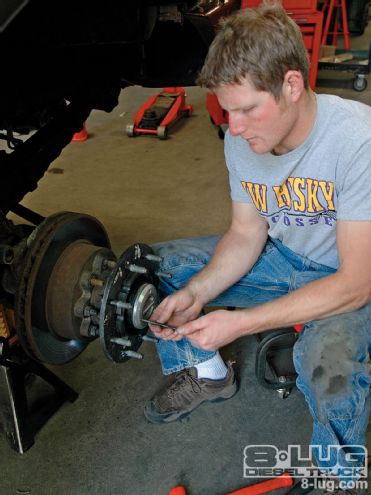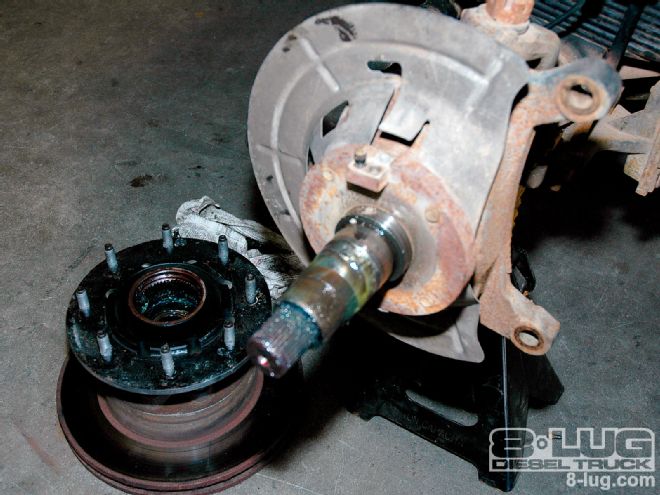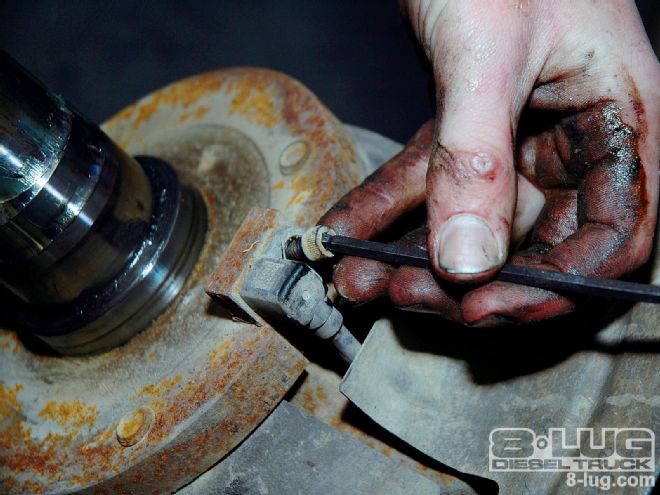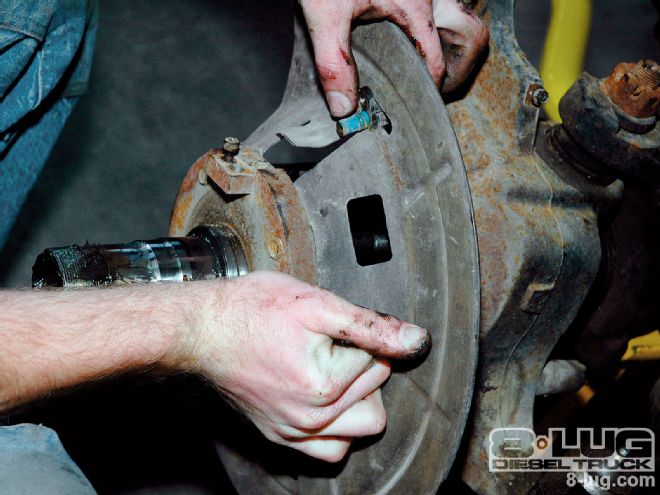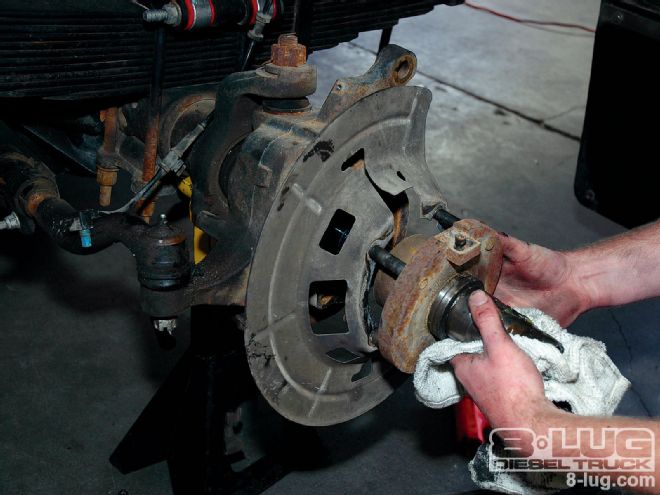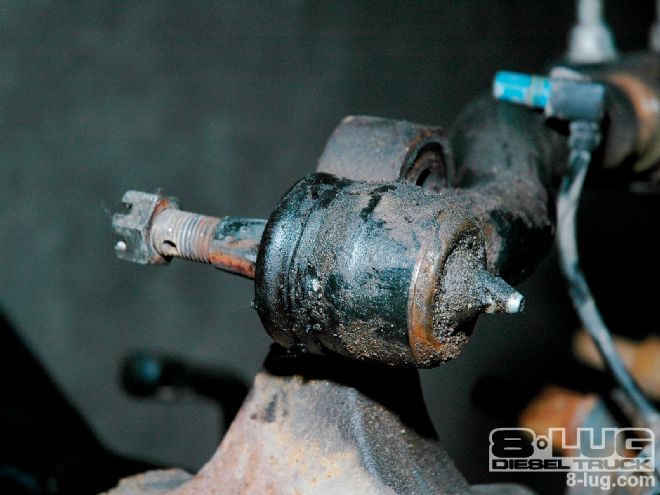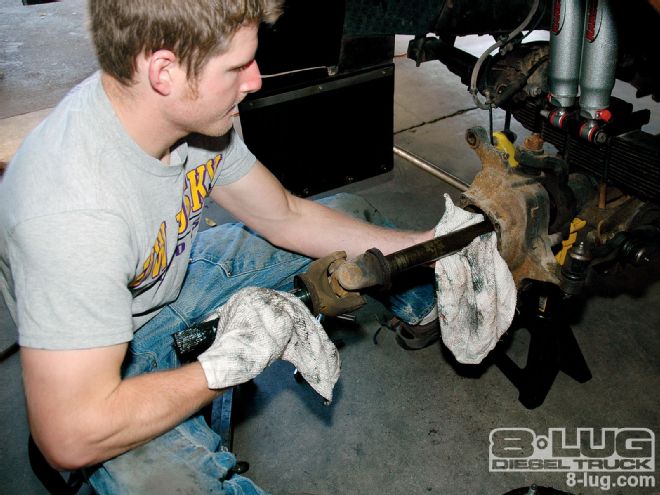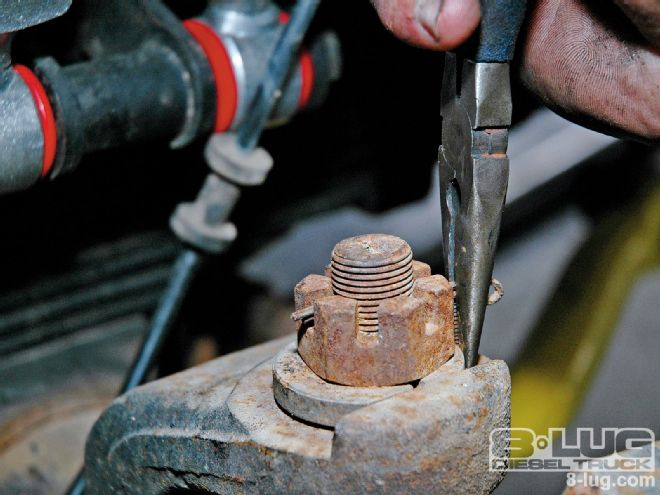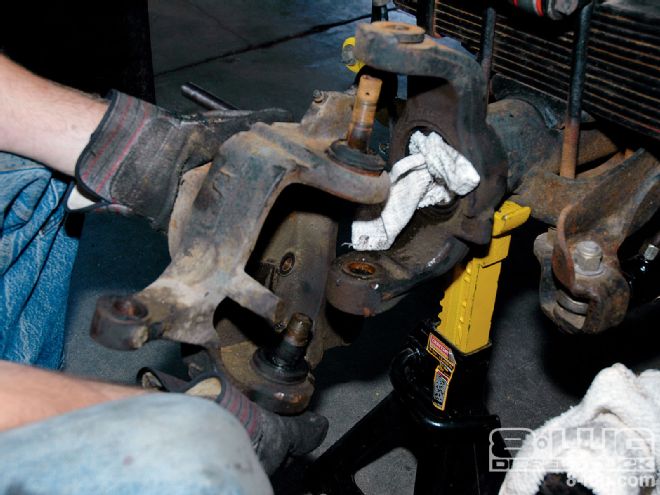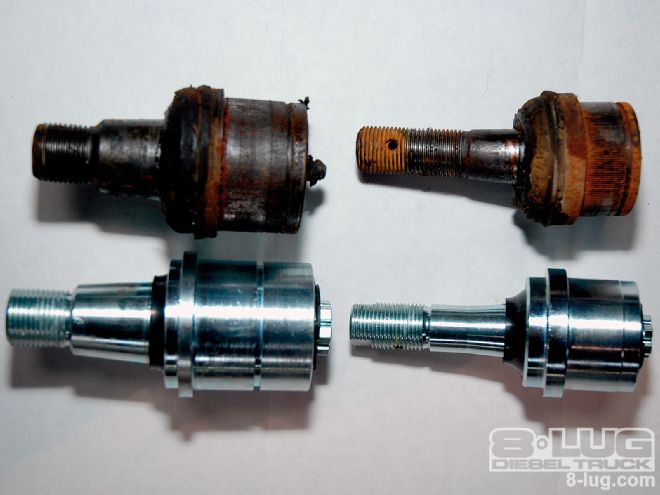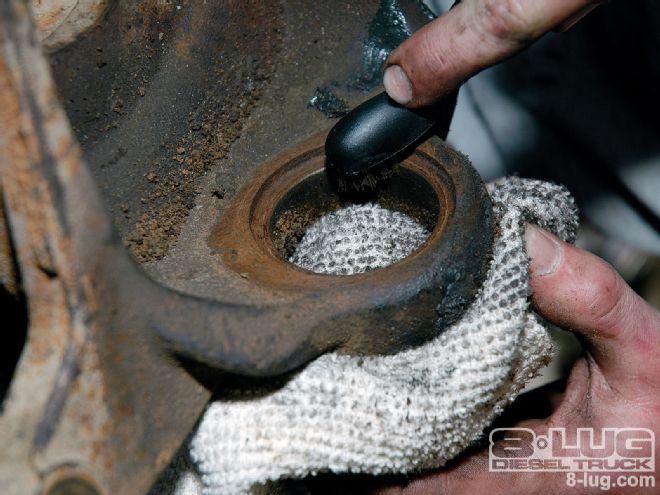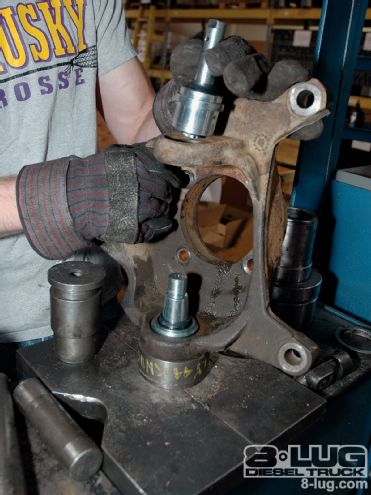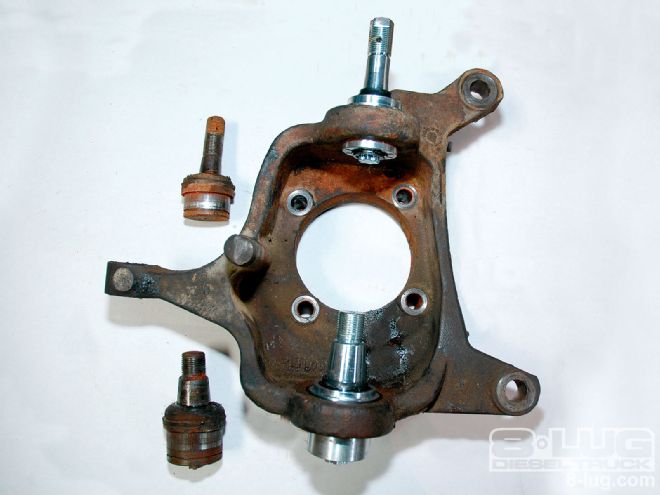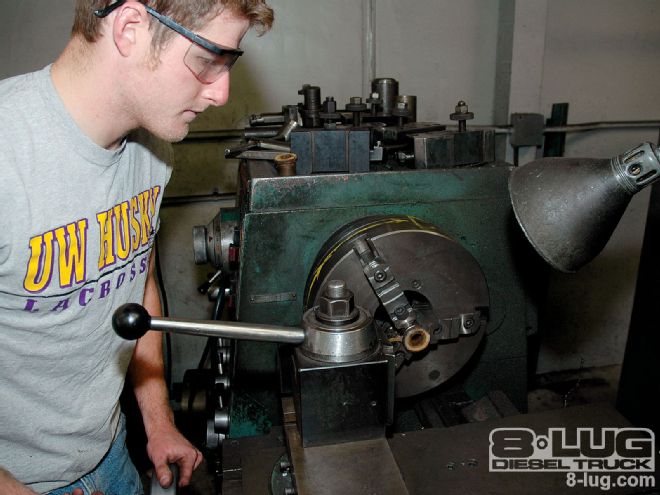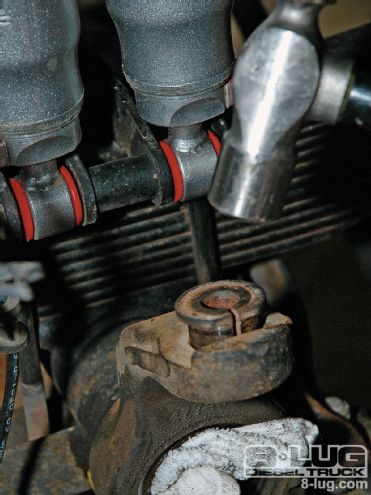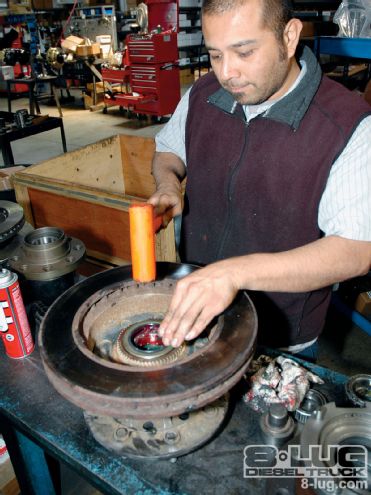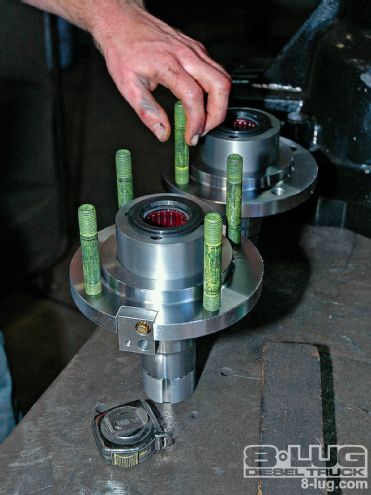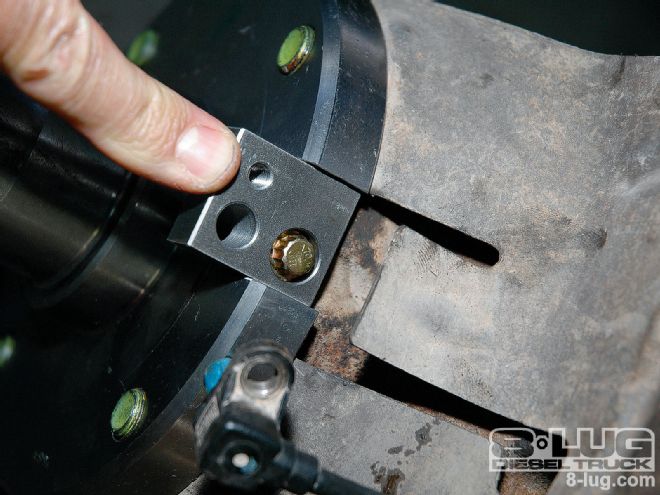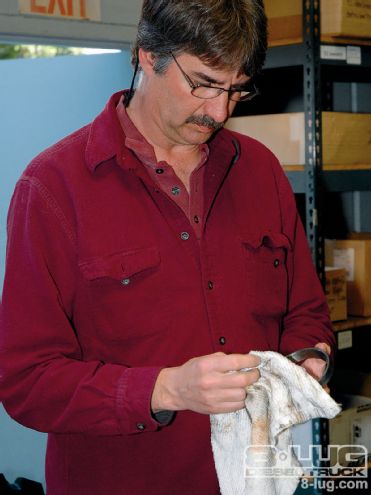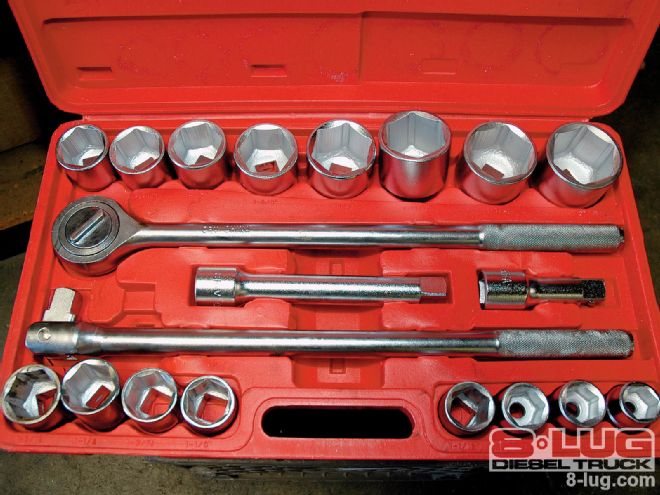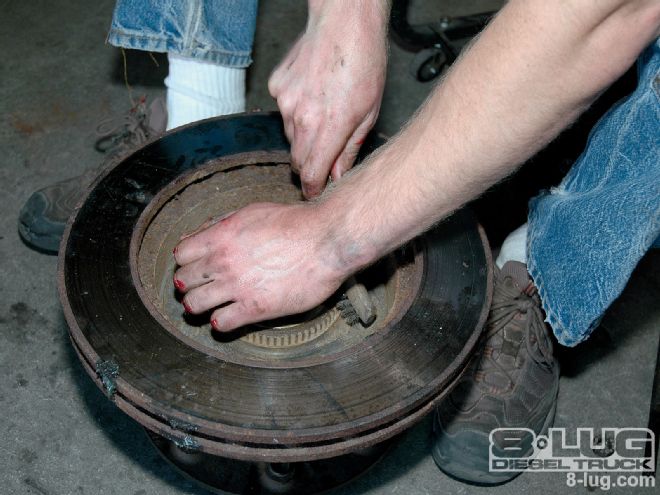If you drive an eight-lug diesel, chances are you use it for more than running to the store for a six-pack of Coke. There's no doubt the truck sees an occasional water crossing, some dust, road salt, and freeway slop. We could also guess you have bigger tires. These probabilities can seriously shorten the life of your ball joints.

| With The Turtle V up on jackstands, the tires were removed and disassembly of the hubs began.
Ball joints you say? What are they? You can't see them. They can't be serviced. Maybe a few have a grease nipple, but most are sealed-yet everything the wheels and tires do on your eight-lug diesel depends on the proper function of the ball joints. Like your hip joint, they connect the upper part of your truck to the lower part. And, like the ball and socket of your hip, they can wear out.
The factory ball joint assembly is a fairly long-wear item. It has seals to keep contaminants out, but there is always some crud that gets in, and the accumulation of moisture and dirt wears away the seals and the plastic or nylon cups the balls ride in. Keeping fresh grease on your ball joints is important if you have fittings, but according to the engineers at Dynatrac, one of the main purposes of regularly lubricating your ball joints is simply to purge the water and dirt that accumulates.
The "ball" element of the typical OEM ball joint rides in a "socket" of metal with a plastic liner. Larger tires and off-roading dramatically increase the cantilever moment of force on the surface of the socket, at times easily exceeding 10,000 pounds. Add a little rust and dirt, and the plastic breaks down to a point where the steel ball is sort of flopping around. The indications of worn ball joints can include wheel shimmy, clunking during a turn, abnormal tire wear, pulling to one side, and loose steering.
Replacing your ball joints is a pretty major job, mainly because aside from needing to take the front hub apart right down to the axlehousing, you need a heavy press to push out the old cups and press the new ones in. That means shop time and money.
Dynatrac, an industry leader in the engineering and manufacturing of top-quality drivetrain, axle, and off-road accessories for drivers of all disciplines, recognized the need for a more durable, user-friendly ball joint design. Jim McGean, president of Dynatrac, told us he wanted to engineer a ball joint that was easily serviceable-in the field or in the garage-so that enthusiasts of all levels wouldn't be faced with the downtime and expense of a shop or dealer-installed ball joints.
The result, introduced at last year's SEMA Show in Las Vegas, is the new, heavy-duty ProSteer ball joint, engineered to deliver premium performance and increased reliability for Dana 60 front axle trucks, including '92-to-present Ford F-250 and F-550 Super Dutys and '03-to-'09 Dodges.
Built to the same exacting standards as every Dynatrac product, the new Dynatrac ProSteer ball joints feature high-strength, billet steel bodies; extra-strength chromoly steel and heat-treated stems; leak-proof seals; mil-spec, heat-treated, precision-ground, stainless steel balls; and Teflon-coated internal wear points. Designed for do-it-yourselfers, the ProSteer ball joint can also be easily rebuilt in the field without any special equipment, lowering repair costs and vehicle downtime. The new ProSteer ball joint improves on- and off-road vehicle performance and delivers unsurpassed strength and reliability compared to OEM units.
Always looking for ways to improve our own Ford Super Duty, when Dynatrac offered to install the new ProSteer ball joints, we gladly accepted. Craig Smith, one of Dynatrac's engineers, volunteered to get his hands greasy. Our OEM-style ball joints were starting to show wear from big tires and thousands of miles of backroad exploring in Baja California.
With the truck up on jacks, the wheels were removed and the hub parts were disassembled. The brake calipers were removed, our DynaLoc hubs were taken off, tie rods were disconnected and tied up out of the way, and with the rotor, dust cover, ABS sensor, and spindle off, the axles were carefully slid out. A rag covered the tube end to keep gear oil in and prevent contamination of the seals.
Now we could finally see the ball joints, or at least the nuts that hold them in place inside the end forging of the axlehousing. The cotter pins were removed and the big nuts (top and bottom) were loosened with a 15/16-inch socket so that a few raps with a big hammer would dislodge the ball joint stems. The lower nut was left in place to prevent the knuckle from falling on the floor.
Now we moved to Dynatrac's 15-ton industrial press to push out the joints. After a thorough cleaning of the knuckle, the new ball joints were pressed in. There is no plastic bushing in the Dynatrac design like the OEM ball joints. The Dynatrac ProSteer ball joint has Teflon-coated precision internal surfaces for long life.
While we had everything apart, the Timken bearings in Dynatrac's Free-Spin replacement kits were inspected and repacked, and new Spicer seals were installed. The DynaLoc hubs were lubricated and checked for any unusual wear.
During reassembly, Craig showed us some important tricks. The lips on the factory camber bushings were machined down 1/8 inch to ensure the new ball joint bodies could be drawn up fully into their place. Craig used a small spacer to keep the camber bushing from fully seating, first tightening the upper nut to draw the lower joint up tight. Because the lower ball stud uses an aircraft-type lock nut, it will spin unless it has been drawn up snug.
To keep the upper stem from spinning, Craig held the top with a second wrench as he tightened the nut. Finally, both were torqued to 150 pounds on the bottom and 75 to 80 pounds on the top, aligning the slots for the cotter pin.
We can now expect years of trouble-free driving from our Super Duty, and when service is needed on the ProSteer ball joints, it will be much easier with a simple rebuild/service kit.
The cost of a full set for both sides of a front axle is $599. Not cheap-but extreme quality, design, and durability have their price. Driven by the mission to give enthusiasts the "Confidence to Explore," for more than two decades, Dynatrac has manufactured drivetrain components built to the exacting standards of the world's most demanding vehicle enthusiasts, including those who dabble in heavy-duty military equipment and extreme off-roading. Dynatrac products are designed and manufactured entirely in the United States.
If your eight-lug diesel is new, keep fresh, clean grease in those joints that have fittings at regular intervals. If you're starting to feel the telltale sign of worn joints-wheel shimmy, clunking during a turn, abnormal tire wear, pulling to one side, or loose steering-the new Dyantrac is a serious upgrade to consider.
